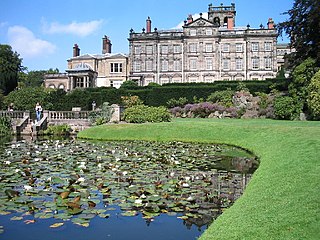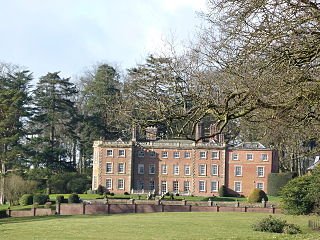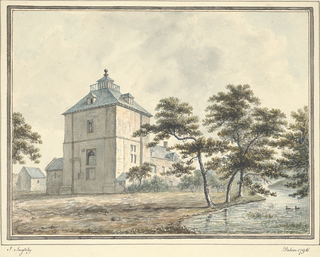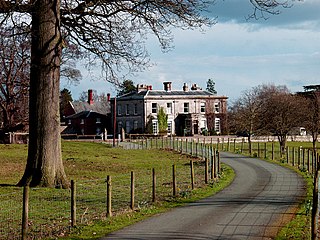
Weston Park is a country house in Weston-under-Lizard, Staffordshire, England, set in more than 1,000 acres (400 ha) of park landscaped by Capability Brown. The park is located 10 miles (16 km) north-west of Wolverhampton, and 8 miles (13 km) east of Telford, close to the border with Shropshire. The 17th-century Hall is a Grade I listed building and several other features of the estate, such as the Orangery and the Stable block, are separately listed as Grade II.

Wrockwardine is a village and civil parish in the borough of Telford and Wrekin and ceremonial county of Shropshire, England. It lies north of The Wrekin and the M54/A5, and west of Wellington.

Thomas Bower (1838–1919) was an English architect and surveyor based in Nantwich, Cheshire. He worked in partnership with Ernest H. Edleston at the Nantwich firm Bower & Edleston, which he founded in 1854. He is particularly associated with the Gothic Revival style of architecture.

Downton Hall is a privately owned 18th-century country house at Stanton Lacy, near Ludlow, Shropshire. It is a Grade II* listed building.
Hampton Hall is a country house in Worthen, Shropshire.

Shropshire is a county in the West Midlands region of England. In 2009, the historic county was divided into two unitary authorities, Shropshire and Telford and Wrekin. These two unitary authorities constitute the ceremonial county of Shropshire, which forms the basis for this list. The county's economy is largely agricultural. Until the creation of the new town of Telford in the 1960s, the largest town was its county town, Shrewsbury. Shropshire is the largest entirely inland county in England. Its churches are mainly constructed from local stone. This is mainly sandstone, although there are limestone deposits in the northeast of the county. The Triassic sandstone from quarries at Grinshill is considered to be one of the finest types of stone in the county for building.

Wattlesborough Tower is a ruined fortified 13th-century manor house or Tower House in Shropshire. It is situated close to the boundary with Powys in Wales. Wattlesborough is a former township within the present parish of Alberbury. The castle is a Grade 1 listed scheduled monument. The Tower comprises a square two-storey tower above an undercroft surrounded by a moated enclosure with a fishpond. The Leighton family inherited Wattlesborough in 1471 and used it as their chief residence until circa 1711. At that time an adjoining farm building was constructed and named Wattlesborough Hall.

St Giles' Church is in the hamlet of Barrow, Shropshire, England. It is an active Anglican parish church in the deanery of Telford Severn Gorge, the archdeaconry of Ludlow, and the diocese of Hereford. Its benefice is united with those of All Saints, Broseley, St Mary, Jackfield, St Bartholomew, Benthall, and St Leonard, Linley. The church is recorded in the National Heritage List for England as a designated Grade I listed building. It is one of the earliest surviving churches in Shropshire, and contains the county's only Anglo-Saxon chancel.

Edward Haycock Sr. was an English architect working in the West Midlands and in central and southern Wales in the late Georgian and early Victorian periods.

John Hiram Haycock (1759-1830) was an architect who built many notable buildings in Shropshire and Montgomeryshire. He was the son of William Haycock (1725-1802), a carpenter and joiner of Shrewsbury. He was apprenticed to his father and became a freeman of the Shrewsbury Carpenters’ and Bricklayers’ Company in 1796. From about 1814 he worked in partnership with his son Edward Haycock, Sr., and became the Shropshire county surveyor in 1824.

Burford House is an 18th-century country house in Burford, Shropshire, near Tenbury Wells, Worcestershire, England. It now functions as a garden centre, cafe, garden and retail outlet.
Grinshill is a civil parish in Shropshire, England. It contains 20 listed buildings that are recorded in the National Heritage List for England. Of these, one is at Grade II*, the middle of the three grades, and the others are at Grade II, the lowest grade. The parish contains the village of Grinshill and the surrounding countryside. To the north of the village is a former quarry that produced sandstone described as "the finest building stone in Shropshire". This is used in the construction of many of the buildings in the village and elsewhere in the county. Most of the listed buildings are houses and associated structures, farmhouses and farm buildings, and the other listed buildings consist of a church, and items in and around the churchyard,
Longden is a civil parish in Shropshire, England. It contains 19 listed buildings that are recorded in the National Heritage List for England. All the listed buildings are designated at Grade II, the lowest of the three grades, which is applied to "buildings of national importance and special interest". The parish contains the village of Longden and smaller settlements, and is otherwise rural. Most of the listed buildings are farmhouses, farm buildings, houses, and cottages, the older buildings being timber framed. The other listed buildings include a church, a small country house, a milestone, and a gazebo.
Onibury is a civil parish in Shropshire, England. It contains 25 listed buildings that are recorded in the National Heritage List for England. Of these, two are at Grade II*, the middle of the three grades, and the others are at Grade II, the lowest grade. The parish contains the village of Onibury and the surrounding countryside. Most of the listed buildings are houses, cottages, farm houses and farm buildings, the earliest of which are timber framed. The oldest building is a church, which is listed together with items in the churchyard. In the parish are a country house and a mansion, both of which are listed, together with associated structures. The other listed buildings include a gazebo, a former railway station, a war memorial, and a telephone kiosk.
Shipton is a civil parish in Shropshire, England. It contains nine listed buildings that are recorded in the National Heritage List for England. Of these, one is listed at Grade I, the highest of the three grades, two are at Grade II*, the middle grade, and the others are at Grade II, the lowest grade. The parish contains the village of Shipton and the surrounding area. In the parish is Shipton Hall, a country house that is listed together with associated structures. The other listed buildings are a church originating from the 12th century and houses, the earliest of which are timber framed, one with cruck construction.
Sutton Maddock is a civil parish in Shropshire, England. It contains six listed buildings that are recorded in the National Heritage List for England. Of these, one is listed at Grade II*, the middle of the three grades, and the others are at Grade II, the lowest grade. The parish contains the settlements of Sutton Maddock and Brockton, and is otherwise rural. The listed buildings consist of houses and a church.
Wrockwardine is a civil parish in the district of Telford and Wrekin, Shropshire, England. It contains 56 listed buildings that are recorded in the National Heritage List for England. Of these, one is listed at Grade I, the highest of the three grades, four are at Grade II*, the middle grade, and the others are at Grade II, the lowest grade. The parish contains villages and smaller settlements, including Wrockwardine, Admaston, Allscott, Leaton, and Walcot, and is otherwise rural. Most of the listed buildings are houses and associated structures, cottages, farmhouses and farm buildings, many of which are timber framed. The other listed buildings include churches, items in churchyards, a country house and associated structures, a milepost, a former toll house, a school, almshouses, a hotel, and a rifle target gallery.
Wrockwardine Wood and Trench is a civil parish in the district of Telford and Wrekin, Shropshire, England. The parish contains four listed buildings that are recorded in the National Heritage List for England. All the listed buildings are designated at Grade II, the lowest of the three grades, which is applied to "buildings of national importance and special interest". The parish is a suburb of the town of Telford, and the listed buildings consist of a former steam mill, a church, a rectory, and public house.

Oakly Park, Bromfield, Shropshire, England is a country house dating from the 18th century. In the early 19th century, the house was restored and extended by Charles Robert Cockerell, Surveyor to the Bank of England for his friend Robert Henry Clive. The private home of the Earls of Plymouth, Oakly Park is a Grade II* listed building.

Clun Town Hall is a municipal building in The Square in Clun, Shropshire, England. The building, which is now used as a museum, is a Grade II* listed building.













